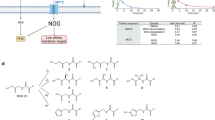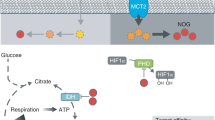Abstract
Background
Methylglyoxal (MGO) is a known toxic byproduct of glycolysis, with MGO-induced cytotoxicity believed to contribute to the pathogenesis of several diseases. Glyoxalase I (GLO1) is a key enzyme for eliminating MGO in mammalian cells, therefore, compounds affecting GLO1 activity are potential therapeutic agents for MGO-induced disorders. Previously, we found nordihydroguaiaretic acid (NDGA) as a potent GLO1 inhibitor.
Methods
The inhibitory characteristics of NDGA were determined spectrophotometrically with recombinant GLO1. NDGA-induced growth-inhibition and accumulation of MGO-derived advanced glycation end products (AGEs) were examined in EA.hy926 cells.
Results
NDGA showed significant inhibition of GLO1 enzymatic activity in a dose-dependent manner. Its Ki value was estimated to be 146-fold lower than that of myricetin, a known GLO1 inhibitor. The co-addition of MGO with NDGA to the cells resulted in significant growth inhibition, suggesting that MGO accumulation, sufficient to affect cell growth, was caused by NDGA inhibiting GLO1. These findings were supported by the observations that the addition of aminoguanidine, a typical MGO scavenger, significantly reversed cell-growth inhibition by co-addition of MGO with NDGA, and that an increase in intracellular MGO-derived AGEs was observed during incubation with the co-addition of MGO with NDGA.
Conclusion
NDGA was found to be a novel and potent inhibitor of GLO1. The co-addition of NDGA with MGO to the cells resulted in increased intracellular MGO accumulation followed by enhanced cell-growth inhibition.





Similar content being viewed by others
Data Availability
The data generated during and/or analyzed during the current study are available from the corresponding author on reasonable request.
Code Availability
Not applicable.
References
Allaman I, Bélanger M, Magistretti PJ (2015) Methylglyoxal, the dark side of glycolysis. Front Neurosci 9:23. https://doi.org/10.3389/fnins.2015.00023
He Y, Zhou C, Huang M et al (2020) Glyoxalase system: A systematic review of its biological activity, related-diseases, screening methods and small molecule regulators. Biomed Pharmacother 131:110663. https://doi.org/10.1016/j.biopha.2020.110663
Kalapos MP (2008) The tandem of free radicals and methylglyoxal. Chem Biol Interact 171:251–271. https://doi.org/10.1016/j.cbi.2007.11.009
Rabbani N, Xue M, Thornalley PJ (2016) Dicarbonyls and glyoxalase in disease mechanisms and clinical therapeutics. Glycoconj J 33:513–525. https://doi.org/10.1007/s10719-016-9705-z
Bellier J, Nokin M-J, Lardé E et al (2019) Methylglyoxal, a potent inducer of AGEs, connects between diabetes and cancer. Diabetes Res Clin Pract 148:200–211. https://doi.org/10.1016/j.diabres.2019.01.002
Banerjee S (2021) Biophysical and mass spectrometry based characterization of methylglyoxal-modified myoglobin: Role of advanced glycation end products in inducing protein structural alterations. Int J Biol Macromol 193:2165–2172. https://doi.org/10.1016/j.ijbiomac.2021.11.047
Donnellan L, Young C, Simpson BS et al (2022) Proteomic Analysis of Methylglyoxal Modifications Reveals Susceptibility of Glycolytic Enzymes to Dicarbonyl Stress. Int J Mol Sci 23:3689. https://doi.org/10.3390/ijms23073689
Neeper M, Schmidt AM, Brett J et al (1992) Cloning and expression of a cell surface receptor for advanced glycosylation end products of proteins. J Biol Chem 267:14998–15004. https://doi.org/10.1016/S0021-9258(18)42138-2
Watanabe M, Toyomura T, Wake H et al (2019) Differential contribution of possible pattern-recognition receptors to advanced glycation end product-induced cellular responses in macrophage-like RAW264.7 cells. Biotechnol Appl Biochem. https://doi.org/10.1002/bab.1843
Cepas V, Collino M, Mayo JC, Sainz RM (2020) Redox Signaling and Advanced Glycation Endproducts (AGEs) in Diet-Related Diseases. Antioxidants 9:142. https://doi.org/10.3390/antiox9020142
Kalapos MP, Littauer A, de Groot H (1993) Has reactive oxygen a role in methylglyoxal toxicity? A study on cultured rat hepatocytes. Arch Toxicol 67:369–372. https://doi.org/10.1007/BF01973710
Miyazawa N, Abe M, Souma T et al (2010) Methylglyoxal augments intracellular oxidative stress in human aortic endothelial cells. Free Radic Res 44:101–107. https://doi.org/10.3109/10715760903321788
Chan C-M, Huang D-Y, Huang Y-P et al (2016) Methylglyoxal induces cell death through endoplasmic reticulum stress-associated ROS production and mitochondrial dysfunction. J Cell Mol Med 20:1749–1760. https://doi.org/10.1111/jcmm.12893
Wang G, Wang Y, Yang Q et al (2022) Metformin prevents methylglyoxal-induced apoptosis by suppressing oxidative stress in vitro and in vivo. Cell Death Dis 13:29. https://doi.org/10.1038/s41419-021-04478-x
Schalkwijk CG, Stehouwer CDA (2020) Methylglyoxal, a Highly Reactive Dicarbonyl Compound, in Diabetes, Its Vascular Complications, and Other Age-Related Diseases. Physiol Rev 100:407–461. https://doi.org/10.1152/physrev.00001.2019
Bellahcène A, Nokin M-J, Castronovo V, Schalkwijk C (2018) Methylglyoxal-derived stress: An emerging biological factor involved in the onset and progression of cancer. Semin Cancer Biol 49:64–74. https://doi.org/10.1016/j.semcancer.2017.05.010
Watanabe M, Toyomura T, Tomiyama M et al (2020) Advanced glycation end products (AGEs) synergistically potentiated the proinflammatory action of lipopolysaccharide (LPS) and high mobility group box-1 (HMGB1) through their direct interactions. Mol Biol Rep 47:7153–7159. https://doi.org/10.1007/s11033-020-05783-y
Arai M, Nihonmatsu-Kikuchi N, Itokawa M et al (2014) Measurement of glyoxalase activities. Biochem Soc Trans 42:491–494. https://doi.org/10.1042/BST20140010
Watanabe M, Toyomura T, Wake H et al (2017) Advanced glycation end products attenuate the function of tumor necrosis factor-like weak inducer of apoptosis to regulate the inflammatory response. Mol Cell Biochem 434:153–162. https://doi.org/10.1007/s11010-017-3045-6
Lü J-M, Nurko J, Weakley SM et al (2010) Molecular mechanisms and clinical applications of nordihydroguaiaretic acid (NDGA) and its derivatives: An update. Med Sci Monit Int Med J Exp Clin Res 16:RA93–R100
Floriano-Sánchez E, Villanueva C, Medina-Campos ON et al (2006) Nordihydroguaiaretic acid is a potent in vitro scavenger of peroxynitrite, singlet oxygen, hydroxyl radical, superoxide anion and hypochlorous acid and prevents in vivo ozone-induced tyrosine nitration in lungs. Free Radic Res 40:523–533. https://doi.org/10.1080/10715760500419365
Seufferlein T, Seckl MJ, Schwarz E et al (2002) Mechanisms of nordihydroguaiaretic acid-induced growth inhibition and apoptosis in human cancer cells. Br J Cancer 86:1188–1196. https://doi.org/10.1038/sj.bjc.6600186
Meyer GE, Chesler L, Liu D et al (2007) Nordihydroguaiaretic acid inhibits insulin-like growth factor signaling, growth, and survival in human neuroblastoma cells. J Cell Biochem 102:1529–1541. https://doi.org/10.1002/jcb.21373
Rowe DL, Ozbay T, Bender LM, Nahta R (2008) Nordihydroguaiaretic acid, a cytotoxic insulin-like growth factor-I receptor/HER2 inhibitor in trastuzumab-resistant breast cancer. Mol Cancer Ther 7:1900–1908. https://doi.org/10.1158/1535-7163.MCT-08-0012
Zavodovskaya M, Campbell MJ, Maddux BA et al (2008) Nordihydroguaiaretic acid (NDGA), an inhibitor of the HER2 and IGF-1 receptor tyrosine kinases, blocks the growth of HER2-overexpressing human breast cancer cells. J Cell Biochem 103:624–635. https://doi.org/10.1002/jcb.21435
Li X, Fan S, Pan X et al (2016) Nordihydroguaiaretic acid impairs prostate cancer cell migration and tumor metastasis by suppressing neuropilin 1. Oncotarget 7:86225–86238. https://doi.org/10.18632/oncotarget.13368
Song X, Tan L, Wang M et al (2021) Myricetin: A review of the most recent research. Biomed Pharmacother 134:111017. https://doi.org/10.1016/j.biopha.2020.111017
Ahmed N, Argirov OK, Minhas HS et al (2002) Assay of advanced glycation endproducts (AGEs): surveying AGEs by chromatographic assay with derivatization by 6-aminoquinolyl-N-hydroxysuccinimidyl-carbamate and application to Nepsilon-carboxymethyl-lysine- and Nepsilon-(1-carboxyethyl)lysine-modified albumin. Biochem J 364:1–14. https://doi.org/10.1042/bj3640001
Acknowledgements
This study was supported by JSPS KAKENHI Grant Numbers 21K06657 and 21K06701, the Sanyo Broadcasting Foundation, the Wesco Scientific Promotion Foundation, and the Ryobi Teien Memory Foundation.
Funding
JSPS KAKENHI Grant Numbers 21K06657 and 21K06701, the Sanyo Broadcasting Foundation, the Wesco Scientific Promotion Foundation, and the Ryobi Teien Memory Foundation.
Author information
Authors and Affiliations
Corresponding author
Ethics declarations
Conflicts of interest/Competing interests:
The authors declare no conflicts of interest associated with this manuscript.
Ethics approval
Not applicable.
Consent to participate
Not applicable.
Consent for publication
Not applicable.
Additional information
Publisher’s Note
Springer Nature remains neutral with regard to jurisdictional claims in published maps and institutional affiliations.
Electronic supplementary material
Below is the link to the electronic supplementary material.
Rights and permissions
Springer Nature or its licensor holds exclusive rights to this article under a publishing agreement with the author(s) or other rightsholder(s); author self-archiving of the accepted manuscript version of this article is solely governed by the terms of such publishing agreement and applicable law.
About this article
Cite this article
Watanabe, M., Toyomura, T., Ikegami, R. et al. Nordihydroguaiaretic acid inhibits glyoxalase I, and causes the accumulation of methylglyoxal followed by cell-growth inhibition. Mol Biol Rep 49, 10499–10507 (2022). https://doi.org/10.1007/s11033-022-07929-6
Received:
Revised:
Accepted:
Published:
Issue Date:
DOI: https://doi.org/10.1007/s11033-022-07929-6




